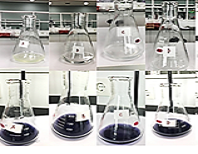Analysis of Hydroquinone in Face Whitening Cream by UV-Vis Spectrophotometry and GC-MS Spectrometry
Abstract
The analytical method to determine the compound content in both food and cosmetic products must be carried out carefully to ensure the validity of the analysis results. Hydroquinone has been widely found to be used as an active whitening agent in whitening cream. Technological advances have led to illegal whitening creams becoming more accessible online. This study aims to examine the hydroquinone content in the whitening samples cream purchased from e-commerce by various analytical methods, such as FeCl3 reagent, cerimetric titration, UV-Vis spectrophotometry, and GC-MS spectrometer compared to the positive control hydroquinone. The results of the hydroquinone content by cerimetric titration and UV-Vis spectrophotometry methods were calculated quantitatively. Furthermore, the result compared through statistical tests showed a consistent hydroquinone content for both methods. Contrariwise, the GC-MS method showed negative results due to differences in the extraction process and solvent solubility. Based on the result obtained, can be concluded that all samples of whitening cream did not meet the requirements of BPOM No. 23 of 2019.
Downloads

Copyright (c) 2024 Karnelasatri Karnelasatri, Candra Yulius Tahya, Mahda Uli Adila, Junius Hardy, Sri Wahyu Ningsih Munthe

This work is licensed under a Creative Commons Attribution-NonCommercial-NoDerivatives 4.0 International License.
Authors who publish with this journal agree to the following terms:
- Copyright on any article is retained by the author(s).
- The author grants the journal, the right of first publication with the work simultaneously licensed under a Creative Commons Attribution License that allows others to share the work with an acknowledgment of the work’s authorship and initial publication in this journal.
- Authors are able to enter into separate, additional contractual arrangements for the non-exclusive distribution of the journal’s published version of the work (e.g., post it to an institutional repository or publish it in a book), with an acknowledgment of its initial publication in this journal.
- Authors are permitted and encouraged to post their work online (e.g., in institutional repositories or on their website) prior to and during the submission process, as it can lead to productive exchanges, as well as earlier and greater citation of published work.
- The article and any associated published material is distributed under the Creative Commons Attribution-NonCommercial-NoDerivatives 4.0 International License.





_copy1.png)










